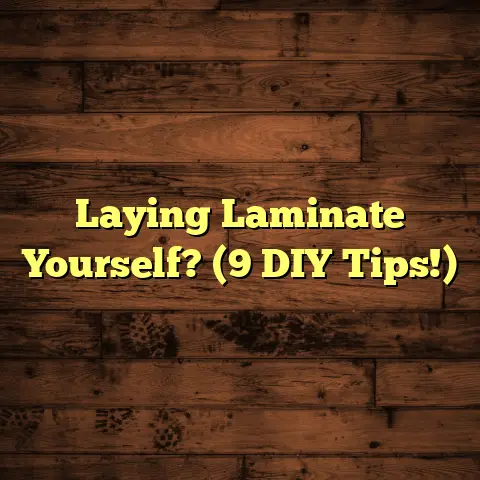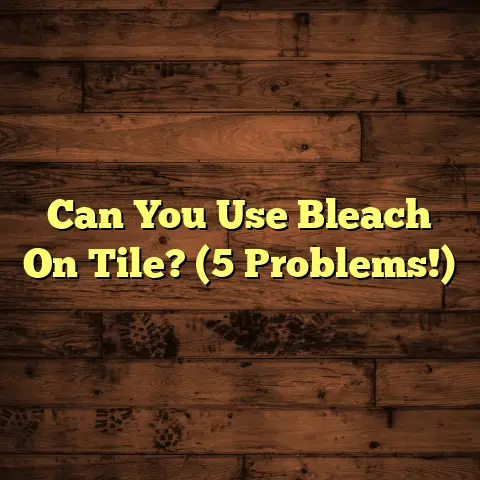How To Remove Black Mold From Cement Floors? (Explained)
I often hear people say that black mold is merely a cosmetic issue.
However, that’s far from the truth.
In my years as a flooring contractor, I’ve witnessed firsthand how black mold can impact not only the appearance of cement floors but also the health of those living within the space.
I remember my first encounter with it in a client’s basement—what started as a small, dark patch quickly grew into a larger problem, affecting both the structure and safety of the home.
Understanding Black Mold
Black mold, scientifically known as Stachybotrys chartarum, thrives in damp and dark conditions.
Cement floors, being porous materials, provide an ideal environment when moisture is present.
You might think you can simply paint over it or scrub it away, but that won’t address the root cause.
Here’s what I’ve learned about tackling this issue effectively.
Conditions for Growth
For black mold to flourish, certain conditions must be met:
- Moisture: This is the primary requirement.
Whether from leaks, high humidity, or flooding, any source of moisture can lead to mold growth. - Temperature: Mold thrives in temperatures ranging from 60°F to 80°F (15°C to 27°C).
- Organic Material: Cement itself is not a food source for mold, but dust, dirt, or organic debris can provide nutrients for growth.
Identifying Black Mold on Cement Floors
Recognizing the presence of black mold early can save you a lot of trouble later on.
Here are some signs to look out for:
Signs of Mold Presence
- Visual Cues: Look for dark spots or patches that appear fuzzy or slimy.
- Odors: A musty smell often accompanies mold growth, which can be a telltale sign.
Assessing Damage
Before taking action, assessing the extent of the mold growth is crucial.
I usually perform a visual inspection first—looking for discoloration and checking for musty odors.
If it appears extensive, I know I’ll need professional help for safe removal; if it’s localized, I handle it myself.
Tools and Materials Required
To get started with mold removal efficiently, here’s what I gather:
Protective Gear
- N95 Respirator Mask: Protects against inhaling mold spores.
- Gloves: Prevents skin contact with mold and cleaning solutions.
- Goggles: Protects eyes from irritants in cleaning solutions.
Cleaning Solutions
There are several options available:
- Vinegar: A natural solution that effectively kills many types of mold.
- Baking Soda: Works well in conjunction with vinegar for scrubbing.
- Hydrogen Peroxide: A stronger option for tougher patches.
- Commercial Mold Removers: Quick results but often contain harsh chemicals.
Scrubbing Tools
- Stiff-bristle Brush: For scrubbing rough surfaces.
- Soft-bristle Brush: Suitable for gentler scrubbing.
- Mop: Essential for rinsing and drying the area afterward.
Step-by-Step Cleaning Process
Once I’ve gathered all necessary tools and materials, I follow these steps:
Step 1: Prepare the Area
Clearing out all furniture and items from the space not only provides me with ample space to work but also keeps belongings safe from damage during cleaning.
Step 2: Protect Yourself
Putting on protective gear is crucial when dealing with mold; working without it is not worth the risk.
Step 3: Apply the Cleaning Solution
Choosing the right solution is key.
Personally, I prefer using a mixture of water and white vinegar because it’s effective and non-toxic.
I spray it generously over affected areas and let it sit for about an hour to penetrate deeply into the mold.
Step 4: Scrubbing Away Mold
After allowing the cleaning solution to work its magic, I take my stiff-bristle brush and begin scrubbing the area.
The key here is to scrub gently but firmly—ensuring I don’t damage the cement surface while effectively removing the mold.
Step 5: Rinse Thoroughly
Rinsing with clean water is essential to remove any residue from the cleaning solution.
I usually use a mop for this step to ensure all areas are cleaned properly.
Step 6: Drying Out
Moisture is mold’s best friend.
After cleaning, I ensure that the area is well-ventilated to dry completely.
Using fans or dehumidifiers can help speed up this process significantly.
Preventing Future Mold Growth
Once the area is clean and dry, I take steps to prevent future mold issues:
Sealants and Protective Measures
Applying a mold-resistant sealant can protect cement floors from future infestations.
It creates a barrier that prevents moisture from penetrating the surface—essentially making it much harder for mold to establish itself again.
Humidity Control Strategies
Maintaining low humidity levels in your home is vital:
- Use dehumidifiers in areas prone to moisture.
- Ensure proper ventilation in basements or crawl spaces.
- Regularly check for leaks in plumbing or roofs that could introduce moisture.
Regular Maintenance Habits
Routine inspections are key in preventing black mold growth—keeping an eye out for potential problem areas allows you to address them before they escalate into bigger issues.
Challenges Encountered During Mold Removal
Every project comes with its challenges.
In this case, one of the biggest hurdles was ensuring complete removal of mold without damaging the underlying cement.
There were also moments where my vinegar solution didn’t seem effective enough for thick patches of mold; in those instances, I found that using hydrogen peroxide or a stronger commercial cleaner worked wonders—but it’s crucial to follow all safety instructions when using harsher chemicals.
Personal Experiences with Difficult Cases
A memorable challenge involved a client whose basement had been flooded multiple times before I arrived on the scene.
The mold had spread extensively along the cement walls and floors—requiring multiple treatments over several days before we finally achieved a satisfactory result.
In another instance, I had overlooked applying sealant after cleaning; within months, we found patches returning despite thorough cleaning efforts earlier on.
This taught me about the importance of preventive measures after remediation work has been completed.
Cost Estimation for Mold Removal Projects
In my experience as a flooring contractor, estimating costs accurately is essential—especially when dealing with mold removal projects where expenses can quickly add up due to materials needed and labor time involved.
Using FloorTally for Accurate Estimates
I rely heavily on FloorTally when calculating costs associated with cleaning supplies, protective gear, sealants, and even potential repairs needed after removal.
The platform generates accurate estimates based on local material and labor rates—making budgeting much easier overall.
Example Scenario 1:
For a moderate-sized basement (about 500 sq ft) with localized mold growth:
- Cleaning Supplies (vinegar, brushes): $50
- Protective Gear (mask, gloves): $30
- Sealant Application (including product): $100
- Total Estimated Cost = $180
Example Scenario 2:
For a more extensive case requiring professional intervention:
- Professional Inspection Fee: $150
- Cleanup Services (labor): $500
- Sealant Application (including product): $100
- Total Estimated Cost = $750
These examples show how FloorTally assists me in providing realistic budgets right from the start—helping build trust with clients who appreciate transparency in pricing.
Comparisons of Different Mold Removal Methods
Over time, I’ve experimented with various methods for removing black mold from cement floors:
- Vinegar and Baking Soda Combination:
- Effective for mild cases but may require multiple applications.
- Safe option but may take longer to see results compared to harsher chemicals.
- Hydrogen Peroxide Treatment:
- A stronger alternative that works well on tougher patches.
- Fast action but requires careful handling due to its reactive nature.
- Commercial Mold Removers:
- Quick results but often contain harsh chemicals that can pose health risks if not used correctly.
- These can be effective but might require more precautions during application compared to natural solutions.
In my experience, a combination of these methods often yields the best results—using vinegar initially followed by hydrogen peroxide for stubborn patches has proven effective time after time.
Practical Tips from My Experience
Here are some general tips I’ve gathered over my years working with flooring projects:
- Always wear protective gear when dealing with mold—safety first!
- Adjust your cleaning approach based on severity—test a small area before applying any cleaner broadly across larger sections.
- Keep your work area ventilated throughout the process—this minimizes inhalation risks associated with spores released during scrubbing activities.
- Consider professional help if you find yourself overwhelmed—sometimes it’s best to leave it to experts who have dealt with extensive infestations regularly.
- Document your process—taking notes or photos can help track progress over time while offering insights into what worked best during remediation efforts!
Engaging with Professionals
Knowing when to call an expert is vital in managing black mold issues effectively:
- Extensive Infestations:
- If you notice widespread growth exceeding small patches across larger areas (like entire rooms), it’s usually best left to professionals who specialize in remediation work.
- Health Concerns:
- If anyone in your household has allergies or respiratory issues exacerbated by exposure to molds—even small amounts—it’s wise to seek outside assistance rather than attempting DIY methods alone!
- Questions to Ask Contractors:
- Always inquire about their experience level dealing specifically with black molds—ask if they follow safety regulations during removal processes!
- Request references or examples of past projects completed successfully; this helps gauge their skill level before hiring anyone!
Personal Stories and Experiences
Reflecting on my encounters throughout various projects reveals both successes achieved along with lessons learned through failures faced during attempts at remediation tasks involving black molds!
Success Stories
One particularly successful removal involved an older couple who discovered black molds spreading along their basement walls after recent flooding events occurred nearby—a thorough cleaning utilizing vinegar followed by sealing off surfaces afterward led us back toward restoring peace within their living space!
Another memorable case involved helping clients purchase new flooring materials after completing remediation efforts—they expressed gratitude toward achieving improved air quality along with aesthetic appeal restored within once-dilapidated spaces now transformed into cozy havens free from hazardous molds!
Lessons Learned from Failures
There have been instances where I underestimated how deeply ingrained molds could become inside porous surfaces like cement; this taught me about persistence needed when tackling such stubborn issues!
In addition, overlooking proper sealing applications post-cleaning work left clients vulnerable again shortly thereafter—it emphasizes why following through entirely matters just as much as initial removal tasks!
Conclusion
Removing black mold from cement floors isn’t merely about aesthetics; it’s about creating safe environments conducive toward healthy living conditions free from hazardous contaminants!
Reflecting back upon key points discussed here—from assessing damage levels down through successful preventative strategies—I hope readers feel empowered while tackling similar challenges faced within their own homes!
If you have your own stories or tips about dealing with black mold impacts in residential settings—I’d love hearing them!
Sharing experiences makes us better equipped collectively toward overcoming common household challenges together!





